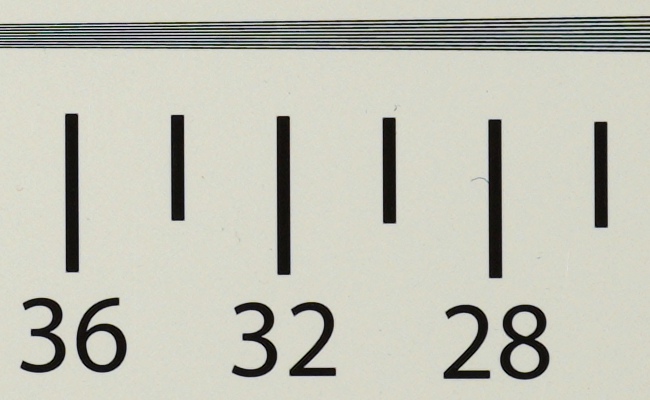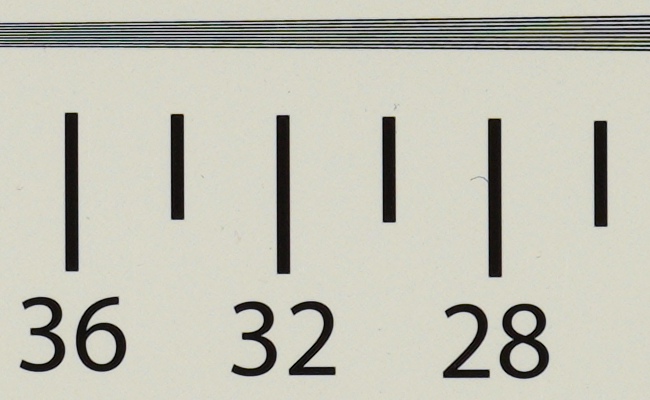Sigma S 500 mm f/5.6 DG DN OS
4. Image resolution
The standard formula, repeated in all our tests, describes well lenses up to a focal length of about 200 mm inclusive. For longer instruments we have to modify it a bit and for two good reasons. We are going to describe these reasons in more detail because, so far, we have never conducted tests of very long focal lengths in an era of mirrorless devices and we feel such an occasion deserves a longer introduction.
Firstly, the influence of errors of all kind increases with the increase of the focal length. In case of tests of wide angle, standard, and moderate tele lenses these errors are so insignificant that they don't affect the final results. In case of 300-600 mm class of focal lengths they start to lower the results slightly. Why? Just because the influence of micro-vibrations of the whole measuring system and the stability of air in a distance of more than a dozen meters from the testing chart mean much more. Of course we try to minimize what we can. In case of such instruments we use the heaviest tripod available and the most solid head, with a declared maximum load exceeding 20 kilograms. We shot our photos with a remote control function, using a 10 second lag. Our studio lighting lamps are so strong that even with ISO 200, typical in our tests, and apertures of f/5.6 and f/8.0 class, we are able to get exposure times of 1/500 of a second. Our direct experience from tests of long telephoto lenses and reflex cameras showed that even after employing all these measures, the final results are always a tad lower than in case of standard models. We are sure these effects won't be diminished after passing to mirrorless cameras, with pixels packed more densely on sensors.
Please Support UsIf you enjoy our reviews and articles, and you want us to continue our work please, support our website by donating through PayPal. The funds are going to be used for paying our editorial team, renting servers, and equipping our testing studio; only that way we will be able to continue providing you interesting content for free. |
- - - - - - - - - - - - - - - - - - - - - - - - - - - - - - - - - - - - - - - - - - - - - - - -
Secondly, you can't break laws of optics. Resolution records are usually broken by lenses as fast as f/1.2 - f/2.0 on stopping down the aperture by 2-3 EV, near f/2.8-4.0. It's quite understandable – at such settings the lens is cut off from most of optical aberrations and diffraction doesn't limit it yet. In case of long telephoto lenses as fast as f/4.0-6.3 that diffraction exactly starts to have crucial significance. The lens cannot exceed 80 lpmm resolution because it would break laws of physics. You can assume that the best f/1.2-2.0 lenses break resolution records in our tests near f/5.6 work already in their diffraction limit. As they get results of 73-75 lpmm by that aperture, such a value can be considered to be that diffraction limit. It means a lens with a maximum aperture of f/5.6 would get such a result only if it was a perfect instrument. As there are no perfect instruments in real world, there are no chances any serial specimen of a lens model gets even close to this value.
A diffraction limit by f/8.0 is a far more possible achievement; after all if you get an f/5.6 lens and, if on stopping down by 1 EV it is practically devoid of any optical aberrations, you still will be dealing with an outstanding result.
Basing on tests of fast standard lenses we know that diffraction limit for f/8.0 amounts to about 63-65 lpmm. You can say it is a good reference point for telephoto lenses which aperture starts from f/5.6-6.3. If your instrument gets close to that value, it means you deal with a really excellent device.
When it comes to the decency benchmark, the criterion doesn't change significantly. In case of our tests the line is set at a diffraction limit of the f/16 aperture. The lenses that are stopped down more significantly can't produce sharp images and such a value is rather objective and doesn't need any modifying. Values at a level of 39-41 lpmm remain in place; still, if you take into account the first point of our divagations, especially these microvibrations that can make themselves felt at the longer focal lengths, you actually should consider rather the lower part of this range, so values of about 39 lpmm.
Armed with such knowledge finally we can glance at the resolution graph of the Sigma S 500 mm f/5.6 DG DN OS.

The result of 65.2 +/- 0.9 lpmm we reached at the maximum relative aperture speaks for itself. In short, it confirms all these 'oohs' and 'aahs' that appeared after publishing the tested lens's sample shots. In a nutshell, by f/8.0, the Sigma reaches the upper part of diffraction limit without any problem; at the same time it is just several lpmm below limit by f/5.6. It is a truly outstanding performance!
If you are still not sure about that assessment you should glance at a graph below. The straight line presents the diffraction limit by particular apertures and it is visible very well for the f/8.0-f/32 range. The closer you get to the maximum relative aperture, the weaker is the performance of the lens as the results stray from straight line more and more.
Extrapolation of the f/8.0-f/32 range line to more open apertures proves what we've written earlier: the diffraction limit by f/5.6 exceeds slightly 70 lpmm and by f/4.0 it is above 80 lpmm. By and large, the tested Sigma strays slightly from the straight line, created by diffraction only by f/5.6, its maximum relative aperture. A really impressive feat indeed!
The edge of the frame can be described in superlatives only. The peak of the performance is achieved by f/5.6 and, at the same time, its level is not significantly lower than the results in the frame centre. The tested Sigma is able to generate very sharp images across the frame and for every aperture ranging from f/5.6 to f/16.0. It would be foolish to ask for anything better.
At the end of this chapter, traditionally, we present crops taken from photos of our resolution chart; they were taken from JPEG files saved along RAW files we used for the analysis above.
| A7R IIIa, JPEG, 500 mm, f/5.6 |
 |
| A7R IIIa, JPEG, 500 mm, f/8.0 |
 |






